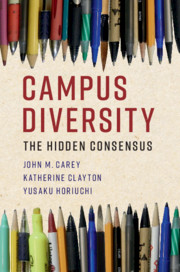Book contents
- Frontmatter
- Dedication
- Contents
- List of Figures
- List of Tables
- Preface
- 1 What We Are Studying, Why, and How
- 2 Roots of the Current Diversity Debates
- 3 Our Conjoint Experiments
- 4 What Students Think: Results across All Students
- 5 How Attitudes Differ across Groups
- 6 How Preferences Differ by Political Beliefs
- 7 What about When All Else Is Not Equal?
- 8 How Student Attitudes Differ from Faculty Attitudes
- 9 Evidence from Other Cases
- 10 What Do the Results Mean?
- Bibliography
- Index
10 - What Do the Results Mean?
Published online by Cambridge University Press: 13 December 2019
- Frontmatter
- Dedication
- Contents
- List of Figures
- List of Tables
- Preface
- 1 What We Are Studying, Why, and How
- 2 Roots of the Current Diversity Debates
- 3 Our Conjoint Experiments
- 4 What Students Think: Results across All Students
- 5 How Attitudes Differ across Groups
- 6 How Preferences Differ by Political Beliefs
- 7 What about When All Else Is Not Equal?
- 8 How Student Attitudes Differ from Faculty Attitudes
- 9 Evidence from Other Cases
- 10 What Do the Results Mean?
- Bibliography
- Index
Summary
The concluding chapter provides a summary of the results reported in the previous chapters, emphasizing the overall preferences in favor of racial/ethnic, gender, and socioeconomic diversity and the broad consensus around these preferences across groups of participants. The chapter then reviews scholarship on how diversity affects campus communities and individual students and faculty, emphasizing that effects at the community level are widely regarded to be positive whereas deeper debates surround impact at the individual level. The chapter concludes by considering current challenges to affirmative action in college admissions in the courts and from those arguing for diversity of viewpoints rather than demographics.
Keywords
- Type
- Chapter
- Information
- Campus DiversityThe Hidden Consensus, pp. 188 - 216Publisher: Cambridge University PressPrint publication year: 2019

